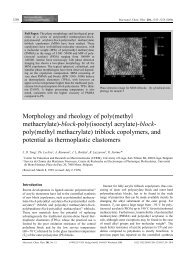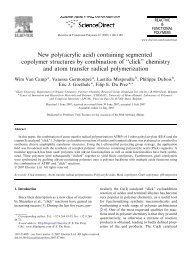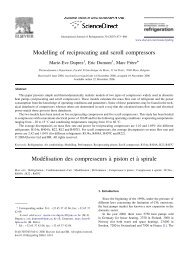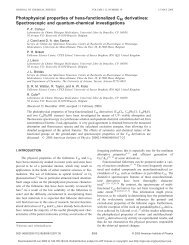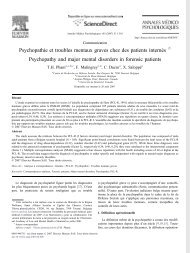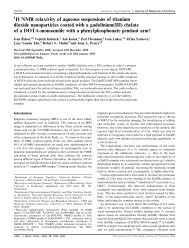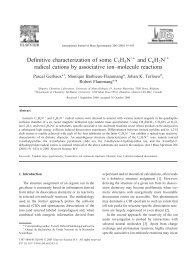Singlet-Singlet Annihilation Leading to a Charge-Transfer ...
Singlet-Singlet Annihilation Leading to a Charge-Transfer ...
Singlet-Singlet Annihilation Leading to a Charge-Transfer ...
Create successful ePaper yourself
Turn your PDF publications into a flip-book with our unique Google optimized e-Paper software.
<strong>Singlet</strong>–<strong>Singlet</strong> <strong>Annihilation</strong>Scheme 1. Molecular structures of PI-(pPh) 1 -PI (1) and PI-(pPh) 2 -PI (2); R= n-octyl, Ar = 4-n-octylphenyl.Results and DiscussionSteady-State MeasurementsFigure 1 displays the normalised steady-state absorption andemission spectra of PI-(pPh) 1 -PI and PI-(pPh) 2 -PI in methylcyclohexane(MCH). The fluorescence quantum yields measuredin degassed conditions are compiled in Table 1. The extinctioncoefficient of the model compound PI-(pPh) 1 measured in <strong>to</strong>lueneis 52000 m 1 cm 1 at 515 nm.Both PI-(pPh) 1 -PI and PI-(pPh) 2 -PI have a large offset in theabsorption energy of the two constituents. The blue parts(350–450 nm) of their spectra originate from the dominantbackbone absorption (pPh units), whereas the bands centredat 520 nm are due <strong>to</strong> the S 0 –S 1 transition of the PI subsystem.While the features and positionof the lowest (S 0 !S 1 ) absorptionband of PI-(pPh) 1 , [17] PI-(pPh) 1 -PI and PI-(pPh) 2 -PI inMCH are nearly identical, the relativeintensity compared <strong>to</strong> tha<strong>to</strong>f the pPh band reflects theratio of PI and pPh units(Figure 1). The PI absorptionband appears slightly unstructuredwhen compared <strong>to</strong> theS 0 !S 1 of the phenyl-substitutedchromophore (C1P1), suggestingsome ground-state delocalisationover the neighbouring pPhunit. [15] Although the maximum and the vibronic structure ofthe absorption band attributed <strong>to</strong> the pPh moiety is situatedat the same wavelength for PI-(pPh) 1 -PI and its single-chromophoreanalogue PI-(pPh) 1 , this band is shifted over 20 nm <strong>to</strong>longer wavelength in PI-(pPh) 2 -PI. In addition, in PI-(pPh) 2 -PI,the fine structure is partially lost, suggesting increased conjugationbetween the pPh subsystems. In the emission spectrain MCH, the maxima (560 nm) and the vibronic shoulders aresimilar <strong>to</strong> previously studied PI-substituted pPh compounds.Again, the maximum and vibronic characteristics of the emissionspectra in MCH are only weakly shifted with respect <strong>to</strong>those of C1P1 in <strong>to</strong>luene. The loss of fine structure in the absorptionspectra and the persistence of the fine structure inthe emission spectra suggest an increased planarity of thepPh n moiety versus the PI moiety in the singlet excited state.We recently demonstrated that PI-(pPh) 1 dissolved in polarsolvents shows an efficient pho<strong>to</strong>induced charge transfer fromthe backbone <strong>to</strong> the end-cap; similar behaviour is expected forPI-(pPh) 1 -PI and PI-(pPh) 2 -PI. [17] The decrease of the quantumyield of the latter compounds in tetrahydrofuran (THF; see theSupporting Information, Table 1 for details) points <strong>to</strong> an improvedefficiency of the radiationless deactivation of the relaxedsinglet excited state. This effect is probably related <strong>to</strong>the dipolar character of the excited state suggested by a systematicredshift of the emission spectra with less pronouncedvibronic features in this solvent (see the Supporting Information,Figure 1 for details).Time-Resolved Experiments on PI-(pPh) 2 -PIFigure 1. Normalised absorption and emission spectra (excitation at 495 nm)of PI-(pPh) 1 -PI (b) and PI-(pPh) 2 -PI (c) in MCH.Table 1. Fluorescence quantum yields, absorption and emission maximaof the compounds PI-(pPh) 1 , PI-(pPh) 1 -PI and PI-(pPh) 2 -PI in MCH.Compound PI-(pPh) 1 PI-(pPh) 1 -PI PI-(pPh) 2 -PIQuantum yield 0.85 0.78 0.72Absorption maximum [nm] 510 515 512Emission maximum [nm] 560 560 562By single-pho<strong>to</strong>n-timing (SPT) experiments, the fluorescenceintensity of PI-(pPh) 2 -PI was found <strong>to</strong> decay monoexponentiallyover the entire wavelength range of the emission spectrumwith a time constant of 2.8 ns (3.5 ” 10 8 s 1 ). Combined withthe fluorescence quantum yield of 0.72, this decay yields a fluorescentrate constant of 2.5”10 8 s 1 . The slightly faster decaycompared <strong>to</strong> C1P1 (2.38 ” 10 8 s 1 , F=1 in <strong>to</strong>luene) at thesame emission maximum suggests a stronger transition dipolemoment. [15]Time-resolved transient absorption spectra obtained uponexcitation at 495 nm with two different excitation powers(60 mW and 400 mW) are depicted in Figure 2. The spectroscop-ChemPhysChem 2007, 8, 1386 – 1393 2007 Wiley-VCH Verlag GmbH & Co. KGaA, Weinheim www.chemphyschem.org 1387



